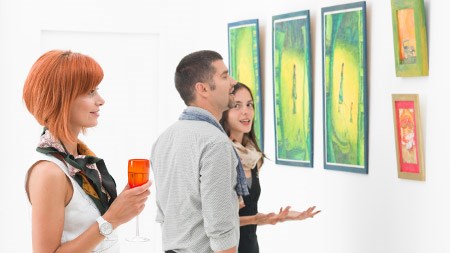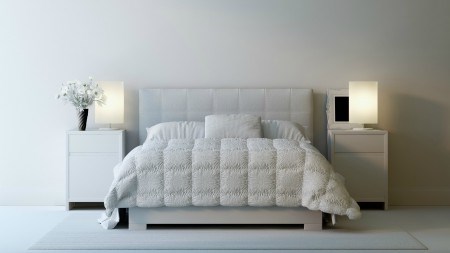Buying artworks for your home can be a costly exercise if you don’t know what you are doing. However, with the right guidance, it can be a satisfying journey of self-discovery.
Art dealers and consultants will always warn you against buying art as an investment. Equally, they will warn you against talking about art in the context of your decor – certainly not within earshot of the artist, that is. But art can be both a good investment, an expression of personal meaning and a way of infusing your home with beautiful objects. It can also be a waste of time and money if you get it wrong.
"Collecting art can become addictive," says Cape Town art dealer João Ferreira, who helps novices and established collectors devise a strategy for curating their own personal collection. Private consultant and curator at the Casa Labia cultural centre, his interest lies in creating debate while facilitating the establishment and enrichment of collections. He runs a programme called Art Conversations in which his clients get together, either alone with him or in a group, to discuss the process of buying art. "This allows novices with little insight to ask what they perceive as silly questions. We debate and develop a rapport until the person has the confidence to make a choice."
Ferreira says he works within the client’s aesthetic to give them insight into pricing structures and to develop connoisseurship. "They gain insights into what makes a painting valuable, and while we advise that buying the work of a blue-chip artist is some guarantee that the art will appreciate, we avoid what i call tokenism – buying a small work by every big-name artist you can lay your hands on. You will not enjoy your collection if you are just ticking boxes."
Ferreira gives collectors the inside track – he takes collectors on gallery visits, introducing them to curators, artists and relevant people on the scene to further flesh out the discourse, which is important in order to prevent the dealer from dictating tastes. "We encourage them to read magazines, look at a lot of art to train their eye – to see and discern. Once they have a lot of information, we guide them on how to use it."
Current trends
South Africans are buying local art like never before. Strauss & co’s annual turnover reached R200 million, indicating a healthy secondary art market. "South African art is very good. South Africans take a lot of pride in what we do and the markets here have shown significant shifts Towards buying South African art. Foreign art is of less interest," says Bedford. South African artworks have also caught the imagination of the global art market, and South African collectors are buying with that market in mind.
"Trends are cyclical," says Read. "Sculpture is where people are putting their money now. South Africans are also buying graphic or minimalist And monochromatic works. In the past they were only interested in easel painting, but painting is not selling that well at the moment. In my opinion, the hottest artist on the South African horizon is Phillemon Hlungwani, whose works on paper I am exhibiting in London." he says savvy collectors are snapping up works by sculptors by Angus Taylor, Lionel Smit, Debbie Bell and Wim Botha.
Bedford, on the other hand, says easel painting still represents the majority of sales at Strauss & co. ‘There is a huge demand for paintings at auction. Erik Laubscher, walter Battiss, Stanley Pinker and Robert Hodgins are selling well at the moment. "Younger artists to watch out for at auctions are Claudette Schreuders, Matthew Hendley and Kudzanai Chiurai. Kemang wa Lehulere has not come to auction yet, but he is making waves in the primary market.
The rarer a work, the more competition there is to buy it when it comes time to auction it. A Jane Alexander sculpture has fetched over a million at Strauss & co, says Bedford. Her work hardly ever comes up for resale. Apart from the quality of her work, the price is affected by the fact that it is so rare. And when two or more bidders compete for one work, the prices can shoot through the roof. Take for example, a Penny Siopis A1 pastel drawing ‘sold for over R600 000 because two people were determined to have it,’ says Bedford.
"South African photography is not as highly sought-after locally as it is internationally, so if a new collector were to be looking for a niche, this would be a good one," says Bedford. Look out for work by David Goldblatt, Guy Tillim, Pieter Hugo, Santu Mofokeng and Andrew putter. The top South African art collector, according to Read, is Piet Viljoen. ‘Anyone wishing to become a collector should take a leaf out of his book.’ Viljoen recently opened a contemporary art space named The New Church in New Church Street in Tamboerskloof in Cape Town to exhibit selections of Viljoen’s contemporary African art collection, which includes names like Avant Car Guard, Bridget Baker, Walter Battiss, Zander Blom, Dineo Seshee Bopape, Willem Boshoff, Wim Botha, Julia Rosa Clark, Steven Cohen, Paul Edmunds, Georgina Gratrix, Nicholas Hlobo, William Kentridge, Moshekwa Langa, Brett Murray, Michael Mcgarry, Serge Alain nitegeka, Robin Rhode, Penny Siopis and Lynette Yiadom-Boakye.
Controversially, according to Viljoen "most art will never, and i do not use this word lightly, show any return at all, except possibly a negative one. So why do we always seem to read about one record-setting auction result after another? Simply, newspapers only report the successes. Like the lottery, we only read about the winning ticket, not the millions of people who lose their whole wager every week. But even the successes are, on closer inspection, not so successful".
Developing the right mind-set
Art is ‘a store of wealth’ rather than a financial investment. In other words, people with money are buying objects of value with their money. Various art indexes have sprung up to track the art market, but beware of using them as a buying guide, because they track the sales of artists by volume – not quality.
Read cautions against setting out to buy art as a financial investment. "Investing in art can be hugely financially rewarding – and has been Phenomenally so over the past few decades. But 99% of art never appreciates. Equally, you don’t buy a couch and expect to retire on it 40 years later. Buy it as part of the decor of a room and if it is a good investment, that is a bonus."
Says Deon Viljoen, "Of course, people make a lot of money buying and selling art, but the primary function of art is to question and to stimulate debate. Some very pricey artworks have no artistic value, so beware. Which is why art needn’t be beautiful. It can be provocative; it should be provocative."
Valuation and provenance
"Provenance is the history of the ownership of a work. Knowing the history helps to eliminate the possibility of buying a fake. If you want to sell the work later, keep all the invoices and letters from the artist if it was a gift. Attach them to the back of the frame," says Bedford.
Amazingly, there are fakes of South African works doing the rounds. "We have some very savvy people in this country making fakes so be very cautious. They use old canvas and old frames. If you buy a fake there is nothing we can do. That is why you must go to the best person who knows the artist, like Strauss & co’s auctioneer Stephan welz if you are looking at an irma Stern."
Artworks can only become investment pieces if each individual work has been correctly valued and its provenance established and documented. Proper due diligence should be embarked on if any doubt regarding the source, provenance or signatures exists. The risk, especially if an artist Is no longer alive, can largely be eliminated by seeking expert advice from ethical and reputable art organisations and art historians.
Trent Read’s advice is: "Be very wary of art people who charge for doing valuations. Someone who gives a work a high value might be charging a percentage so higher value is in his interest. Rather use someone who values conservatively." Many artists base their prices on what previous Pieces have sold for. "It depends on how hungry they are. An artist with a trust fund will price his work higher, while another artist might purposefully price his work lower to put food on the table. Others will keep their prices higher and wait for the right buyer to come along," says Read.
Art for profit vs art for passion
Curator Julia Meintjes buys and sells art, and helps investors and collectors buy and sell art. An expert on historical and contemporary South African art, with over 30 years’ experience in her field, she and her team advise everyone from first-timers to established collectors on how to grow, maintain, document and evaluate their art collection. "We give advice on trends, investment opportunities and on the merit and value of works of art. We have expertise in discerning little-known yet talented artists and providing a platform for them to become better-known. However, we do not limit ourselves to representing particular artists or groups, but rather source work from a wide and diverse range of South African artists from different regions of the country, as well as from studios, galleries, auction houses and private collections."
However, her motivation is not profit, but passion. It is also a treasure hunt – she loves nothing better than the challenge of hunting down that special piece for a particular investor, or introducing a newcomer to the intriguing world of collecting art. "Statistics abound, as do reports about investors all over the world, of both aspirational buyers and specialist collectors placing funds into art as an asset class. The media assists – and sometimes confuses – by continually airing recommendations about collecting and investing in art. For me, the purchase has to be priced fairly, as well as being a work of interest, excellence and importance in an artist’s production. Other criteria – including condition and provenance and how it will 'sing' within a collection or exhibition –are as important, and these considerations may take precedence over price,” says Meintjes.
She is one of a group of curators and private collectors that have turned the Cape Winelands into an art destination, integrating art viewing, wine tasting, food and lifestyle. A winery ambience relieves art of its niche status and displays works in a ‘living’ environment. Her current exhibition at Tokara Wine Estate in Stellenbosch, owned by ex-banker GT Ferreira, is entitled ‘The Garden’. The theme is nature, with Willem Strydom’s bronze on a marble base, ‘Water from an Ancient Well’, as a focal point of the exhibition, which includes works by Irma Stern, Giovanna Biallo, Amy Beatrice Hazell, James Olmesdahl and Johannes Segogela. It demonstrates her individual curatorial style, which is to juxtapose artists from different generations and genres, working in different materials and media, around a central theme.
Meintjes has also made it her business to develop a younger buying audience. She often advises entry-level buyers to buy their contemporaries because they can identify with the subject matter and prices are usually affordable. "Look for artists who are using meaningful visual vocabulary to talk about their world." In 25 or 30 years’, these works will have appreciated. The biggest problem with investing for hardcore financial reasons is that you have to sell the work to realise the profit, she says.
"We sourced a Skotnes panel from a private collection in 1999 for an appropriate R28 000 then, which today would probably be sold for R500 000," she explains. "According to a client of ours in the financial industry, had the R28 000 been invested in the South African stock market in 1999, in the top 40 stocks, and all the dividends reinvested, the investment would be worth R237 000 today. That’s an annualised return of approximately 18 percent. The return on the Skotnes could be more than double this. However, the mechanisms for selling art are more intricate than selling shares and if you have to sell quickly, you have to be prepared to take a drop in price, plus, if you sell at the wrong time it affects the return. Other factors also affect whether a collector can actually realise the investment potential on a work of art – provenance, condition, signature and fashions in the market. Although it is important to purchase astutely, the best reason to buy any work is because you respond to it and want to live with it, rather than to trade with it."
Advice from Corporate Art Curator, Stefan Hundt, Sanlam Private Investment
"Art as a purely financial investment poses challenges. It is highly illiquid, the market lacks transparency and efficiency, and it is expensive to acquire and maintain," says Kyle Sommer of JP Morgan. He also says that, as a store of value, art has shown to be an effective hedge against rising prices when inflation is high.
Research by JP Morgan showed that on average only 10% of the high-net-worth individuals they surveyed own fine art and paintings purely as a financial investment. Motivation for owning art ranged from social status and prestige to the intangible value associated with having a piece of art that you can enjoy.
"On average, art has done significantly better over the last 40 years when inflation runs high. Returns on art appear weakest in a low-inflation environment.’ He says JP Morgan’s analysis of art performance in various environments suggests that art can be used as an effective store of value in prolonged periods of high and rising prices. This is good news for collectors involved in the global art market. But if you are investing in local currency in South African art, things look a little different. While it is possible for South Africans to participate in the global market via online auctions, and even to sell South African works at Bonhams and Christie’s in London, the local market is tiny. South African art is of high quality and well priced, and works are definitely changing hands, says Stefan Hundt, Sanlam art curator and head of Sanlam Private Investment’s art advisory services. To put things into perspective," he says," the market is small in global terms. There are about 500 serious buyers who can spend over R200 000, and only 10 that will spend over R4 million. The entire annual turnover of the South African market is between R250 million and R400 million – that is one painting in America."
Nonetheless, there is a healthy, complex and extremely diverse art market here, with high-net-worth individuals increasingly looking at art as an asset class. Hundt advises clients on investing in art as part of an overall investment portfolio. He is at pains to emphasise that he is not a dealer or a trader – and that there is no magic formula for making the right investment. His strategic advice begins with a client’s capacity to spend money.
Look at artists who are around 30 years old now, who are having success on the exhibition circuit. Don’t avoid work that is confrontational – too many people buy what fits in with their decor scheme.
When buying a work, consider whether the artist has exhibited in prestigious local galleries and in international shows, and whether his or her work has been taken into corporate collections and museums. All of this will contribute to making the work increase in value over time. "Like a stockbroker, I tell people that I cannot predict the future, but we all make better decisions when we are informed. The market is open to manipulation." Hundt is averse to giving laundry lists of which artists to buy: "There is an enormous variance in the quality of work by one artist. Each work is unique, so make sure that you are trained to tell the difference between a good and a bad work by the same artist. If you are a serious collector you will look at work by emerging artists that is disruptive and provocative," he says. "It’s a gamble." However, like all good gamblers, it takes focus – and instinct – to pick a winner! His advice is to take into account the artist’s credentials and track record and the work within its historical art context. By way of example, he mentions conceptual artist Kendell Geers who created an uproar on the South African art scene in the 1980s. His interventions disrupted the conservative, introspective art scene of the day, but today he is a significant player in the European market, says Hundt. At the time, Geers was considered brattish and rude, but he is now an important artist. A work that was bought for R900 in 1989 from the artist recently sold for R200 000.
The Sanlam Art Collection, established in 1965, is one of South Africa’s finest collections of South African art. With holdings of more than 2 000 items by some of South Africa’s most valued and emerging artists, the collection provides a representative overview of South African art dating from the late 19th century to the present. It can be viewed by appointment only. Call Stefan Hundt on 021 947 3357.
Displaying and hanging art
Although artists hate the idea that their work is part of the decor of a room, the room can provide the showcase or context for displaying the works at their best. "I like a room that is pushy," says Read. Framing can be the most expensive part of the art-buying process, but don’t skimp on it. "A frame protects the work. Even if you have to make it yourself, don’t go without," says Bedford.
Moving your collection
Most art is fragile and can be damaged. Consider how you will move it when you buy it. None of the experts we spoke to in this story would recommend a moving company and all had dire warnings about moving art. Dealers usually move art for their clients as a free service. If you are moving, use a reputable mover and make sure you supervise the packing and moving of the art yourself.
Art and wine tasting
- Art is on display at Tokara, where The Garden exhibition will be showing until 31 August 2013. 021 808 5900.
- The personally curated collection of Laurence Graff is open to the public at the Delaire Graff Estate, where the interiors, , such as the William Kentridge-inspired boldly curvaceous tangerine leather banquette, have been designed around some of the pivotal works on display. Works by Deborah Bell, Sidney Kumalo, Fred Schimmel, Durant Sihlali and Cecil Skotnes line the walls of the Tasting Room and restaurant, but guests at the Lodge can enjoy Ndikhumbule Ngqinambi’s and Stephane Graff’s unusual work. 021 885 8160.
- The Jeanetta Blignaut Art consultancy curates the Spier Art collection. The work is cross- disciplinary and incorporates performance, installation, drawing, sculpture, photography, video and film. Works by Kagiso Pat Mautloa, Helen Sebidi, Xolani Moshani and Ricky Dyaloyi, as well as the photography of Pieter Hugo, are on display. Marco Cianfanelli’s ‘The dying Slave’ forms part of the permanent Spier collection and marks the first outdoor three-dimensional piece produced in the Spier Architectural Arts studio. 021 809 1100.
- The art collection at Saronsberg wine Estate near Tulbagh includes works by Colbert Mashile, Angus Taylor and Walter Battiss. 023 230 0707.
- The owners of Leopard’s Leap family Vineyards in Franschhoek are committed to the conservation of the cape mountain leopard and have installed works depicting leopard by Marco Cianfanelli and Dylan Lewis. 021 876 8002.
- Indulge in artworks paired with KWV wines at the KWV Sensorium, Paarl. 0800 212 519.
- A group show arranged by Gordon Froud titled ‘Tom waits for no man’ is currently on at The Gallery at Grande Provence Heritage Wine Estate in Franschoek. 021 876 8600.
Top auction houses
- For international auctions featuring South African work, visit Bonhams at www.bonhams. Com or christie’s at www.christies.com.
- See legendary auctioneer Stephan Welz in action at Strauss & co fine Art Auctioneers & consultants. Visit www.straussart.co.za for details of their auction on 21 october at The vineyard hotel, newlands, cape Town.
- Johannesburg 5th Avenue Auctioneers specialises in South African old masters. Go to www.5thaveauctions.co.za for details. Established in 1891, Cape Town-based Ashbey’s Galleries have held the first exhibitions of some of South Africa’s most respected artists, such as Irma Stern, JH Pierneef and Tinus de Jongh. See www.ashbeysgalleries.co.za for auction dates.
- Stephan welz & co specialises in South African masters and contemporary art. See www. Stephanwelzandco.co.za for upcoming auctions.
For more art experiences
- FNB Joburg Art Fair 2013 is on at the Sandton convention centre from 22 to 24 September.
- Ellerman house is Cape Town’s prestigious Art Hotel: each room features works by top SA masters and contemporary artists. Call 021 430 3200 for a booking.
- Inspired by international events such as the Frieze Sculpture Park in New York, the Winter Sculpture Fair takes place in may each year at the Nirox Sculpture Park near the Cradle of Humankind, outside Johannesburg and Pretoria.
- Art for me, a showcase of contemporary art, will be staged from 25 to 27 october at The Lookout in the V&A waterfront in Cape Town. The Fair is being produced and managed by Fiera Milano, the organisers of Miart in Milan, Italy, and international art Istanbul in Turkey.




